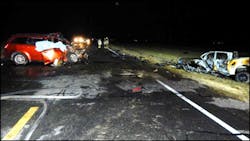NTSB Calls for Alcohol Detection Systems in All New Vehicles
What you'll learn:
- Measures to reduce alcohol-related crashes.
- What technologies are needed for alcohol-impairment detection?
- Potential technologies for speed limiting.
While you can’t always trust statistics, it’s tough to dispute the numbers underpinning the notion that driving under the influence of alcohol remains a leading cause of injury-involved highway crashes. According to the National Highway Traffic Safety Administration (NHTSA), in 2020, roughly one in three traffic fatalities resulted from crashes involving alcohol-impaired drivers.
Since 2000, more than 230,000 people have lost their lives in crashes involving alcohol, again according to NHTSA. In 2020, an estimated 11,654 fatalities occurred in alcohol-impaired crashes. This number represented about 30% of all traffic fatalities that year and a 14% increase over the 10,196 individuals who died because of alcohol-impaired crashes in 2019. This comes at a time when vehicle miles traveled in the U.S. decreased by about 13.2% in 2020.
In response, the National Transportation Safety Board (NTSB) is making a major push to cut down on the number of alcohol-related crashes and deaths. They've asked the NHTSA to require that all new cars have an alcohol detection device in them. This move stems in part from an investigation into a California crash that killed nine – including seven children.
The Avenal, California crash that was the focal point of NTSB’s investigation occurred on New Year’s Day 2021. The NTSB found it was caused by an impaired driver who was speeding. The incident involved a sport utility vehicle (SUV), occupied by only the driver. The SUV driver had just left a New Year’s Day gathering where he had consumed alcohol—his blood alcohol concentration was more than double California’s legal limit of 0.08 grams per deciliter—and he was driving at a speed between 88 and 98 mph.
The SUV crossed the highway centerline and intruded into the northbound lane directly in front of a northbound pickup truck occupied by an adult driver and seven passengers, ranging in age from 6 to 15 years old, traveling at a speed between 64 and 70 mph. The SUV and pickup truck collided head-on. As a result of the crash, the SUV driver and all eight pickup truck occupants died.
After investigating this incident, the safety issues that the NTSB determined had to be addressed include driver impairment and three technological advances:
- The need for technology to prevent alcohol-impaired driving crashes.
- The need for technology to prevent speeding-related crashes.
- The need to implement a uniform standard for drug toxicology testing.
“Technology could’ve prevented this heartbreaking crash—just as it can prevent the tens of thousands of fatalities from impaired-driving and speeding-related crashes we see in the U.S. annually,” said NTSB Chair Jennifer Homendy. “We need to implement the technologies we have right here, right now, to save lives.”
Technology Recommendation Details
The NTSB is recommending measures leveraging new in-vehicle technologies that can limit or prohibit impaired drivers from operating their vehicles as well as technologies to prevent speeding. They include:
- Requiring passive vehicle-integrated alcohol-impairment detection systems, advanced driver monitoring systems, or a combination of the two that would be capable of preventing or limiting vehicle operation if it detects driver impairment by alcohol. The NTSB recommends that the National Highway Traffic Safety Administration require all new vehicles be equipped with such systems.
- Incentivizing vehicle manufacturers and consumers to adopt intelligent speed adaptation systems that would prevent speed-related crashes.
The issues of impaired driving and excessive speeding are both on the NTSB’s Most Wanted List of Transportation Safety Improvements. To prevent alcohol and other drug-impaired driving crashes, the NTSB has called for, as previously mentioned, in-vehicle alcohol detection technology as well as the lowering of the blood alcohol concentration limit to .05 g/dL or lower. They also recommend alcohol ignition-interlock devices for people convicted of driving while intoxicated and that regulators develop a standard of practice to improve drug toxicology testing.
Furthermore, the NTSB has called for a comprehensive strategy to eliminate speeding-related crashes. It would combine traditional measures like enforcement and regulation with new technological advances such as speed limiters and intelligent speed-adaptation technology.
Speed-Limiting Tech
The NTSB is looking for regulators to develop performance standards for such advanced speed-limiting technology targeted at heavy vehicles including trucks, buses, and motor coaches. They want regulators to require all newly manufactured heavy vehicles be equipped with such devices. NTSB also wants:
- To collaborate with traffic safety stakeholders to develop and implement an ongoing program to increase public awareness of speeding as a national traffic safety issue.
- To revise regulations to strengthen requirements for all speed engineering studies and remove the guidance that speed limits in speed zones be within 5 mph of the 85th percentile speed. The 85th percentile speed is the speed at or below where 85% of drivers will operate with open roads and favorable conditions.
- To update speed-enforcement guidelines to reflect the latest automated speed-enforcement technologies and operating practices and promote these guidelines.
Research suggests speeding is a problem that’s worsening. In 2020, there were 11,258 fatalities in crashes in which at least one driver was speeding, according to the NHTSA. This simply underscores that speeding increases both the chances of being involved in a crash and the severity of crash injuries.

